Small Business
Posted on February 9, 2015. Filed under: Email Marketing, Email Results, Marketing, Small Business | Tags: Email List, Events, Growing Your Email List, lead pages, QR Codes, social media, text messages, Webinars |
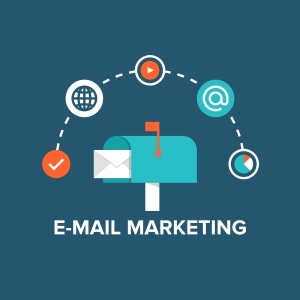 When it comes to your email list, does the size of your list really matter? As a business owner, coach or consultant, you probably already know about the importance of having and growing an email list, but did you know that it’s not the size of your email list that is most important, but the quality of the people on your list? As the saying goes, it is better to have an email list of 100 interested prospects, than 1,000 uninterested people.
When it comes to your email list, does the size of your list really matter? As a business owner, coach or consultant, you probably already know about the importance of having and growing an email list, but did you know that it’s not the size of your email list that is most important, but the quality of the people on your list? As the saying goes, it is better to have an email list of 100 interested prospects, than 1,000 uninterested people.
However, you still want to work on increasing the size of your list because you want to make sure your message is reaching a wider audience each month. Your goal should be to grow your email list with individuals who are interested in what you have to say, and what you have to offer. So the big question is how can you effectively and efficiently grow your email list?
Here are 6 tips to grow your email list:
Offline:
- Events– whenever you conduct an event (workshop, seminar, etc.), or if you are presenting at an event, be sure to collect the email addresses of the attendees (or participants who expressed an interest in learning more) . Be sure to disclosure that by signing your list or providing their information they are agreeing to receiving emails from you.
- Text Messages– Consider adding a text to join your email list option. Now-a-days people don’t leave home without their smart phones, so making it easy for them to join your email list by simply texting a word to a number and then providing their email address makes it easy to join your email list.
- QR Codes- Consider adding QR Codes to your marketing material (business cards, brochures, flyers, etc.) It’s another way to make it easy for people to join your email list. However, I personally don’t really use QR Codes and haven’t gotten a lot of people through this method, but it is still something you could consider.
Online:
- Webinars– a great list building strategy is webinars. When you conduct webinars, people have to give their information to sign up for the webinar. Just add a disclosure that signing up for this webinar also gives you permission to add them to your email list.
- Lead Pages– Another great online list building strategy is to create a lead magnet (eBook, White Paper, Case Study, Checklist, etc.), and have people enter their information on a specially designed lead page that talks about how great your lead magnet is, and why they need to give you their contact information so they can receive your awesome lead magnet. This technique works really well because you know that you are getting people who are interested in the content that you have to offer
- Social Media– Encourage people who follow you on social media to sign-up for your email list so that they can get additional and maybe even exclusive information that you provide only through email. This technique works really well, because if you already have a following on social media, it just makes sense that the next logically step for them is to receive your emails. This also allows the relationship to get stronger when they are not only connected to you via social media, but also receiving your emails.
For more tips, download this Guide Building Your List Can Be a Thing of Beauty by Constant Contact
Read Full Post |
Make a Comment ( None so far )
Posted on January 27, 2015. Filed under: Blog, Business, Marketing, Small Business, Uncategorized | Tags: blog, Blog Content, Blogging |
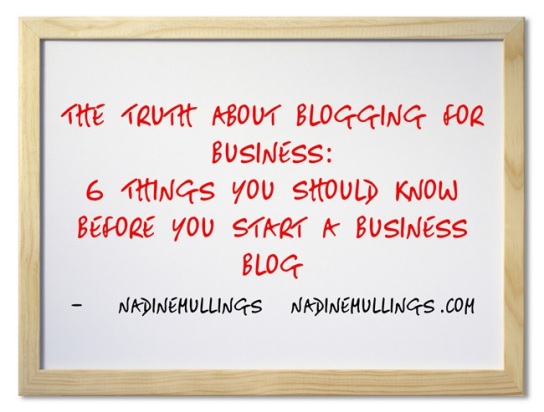 There are many advantages to starting a business blog. In fact, I talked about one of the major benefits of a business blog in my blog post, How to Use Blogging to Build the Know, Like, and Trust Factor for Your Business, but what most people don’t necessarily talk about is the “truth” about blogging. So in this blog post I will uncover some of the truths about blogging for your business:
There are many advantages to starting a business blog. In fact, I talked about one of the major benefits of a business blog in my blog post, How to Use Blogging to Build the Know, Like, and Trust Factor for Your Business, but what most people don’t necessarily talk about is the “truth” about blogging. So in this blog post I will uncover some of the truths about blogging for your business:
- Blogging for business has become very popular in the last five years or so, which has created a crowded blogging world and with so many things grabbing people’s attention, it takes time to get results from your business blog (it can even take years), so if you think blogging for your business will bring you a ton of clients quickly, think again.
- Creating content for your blog takes time. You have to think about the content you want to post, then you have to create the content, and then you have to promote the content, this can take a lot of your time and effort. For example, on average it can take up to two hours to create the blog post, it may take an additional 10-20 minutes to promote the posts on your various social networks, so one blog post can take almost three hours, so depending on how many blog posts you produce per month, this can be very time consuming
- A large percentage of business owners, coaches and consultants manage all aspects of their blog themselves. According to coSchedule, 58% of business bloggers are solo bloggers. That means they are the content manager, the copywriter, the graphic designer, the promoter, and everything else for the blog, which can become overwhelming because of the different elements of running a business blog as well as keeping up with running a business!
- Many blog posts go largely unnoticed. You put all the time and effort into creating content for your blog, and then nobody reads it. That is why promoting your blog post is an important part of blogging for your business. You can promote your blog posts to your email list, on social media, etc.
- A large percentage of business blogs die after a few months because many business owners, coaches and consultants can’t find the time to keep up with the blog. In fact, according to a recent survey by coschedule, 22% of respondents said their biggest challenge when it comes to blogging is finding time, which makes it easy to see why so many business blogs end up in the blog grave yard.
- Most people will not comment on your blog. One of the great things about blogs is the ability to create conversations, because people are able to comment on your blog posts, but the statistics show that the majority of people who may read your blog, will not comment on your blog post, which can make it hard to gauge if you are engaging your audience.
So, if you decide to start a business blog, keep these truths in mind and check out my blog post The 5 C’s of a Successful Business Blog.
Do you have a business blog? Are you thinking about starting a business blog this year?
Read Full Post |
Make a Comment ( None so far )
Posted on December 22, 2014. Filed under: Blog, Business, Business Development, Educating, Marketing, Small Business, Uncategorized | Tags: Blogging, community, Consistency, content, conversations, conversion, Marketing Strategy, small business marketing, small business owner |
 As a small business owner, blogging can play a key role in your marketing strategy. As mentioned in my prior post, How to Use Blogging to Build the Know, Like and Trust Factor For Your Business, blogging allows you to build those key factors that can allow you to have an advantage in the marketplace.
As a small business owner, blogging can play a key role in your marketing strategy. As mentioned in my prior post, How to Use Blogging to Build the Know, Like and Trust Factor For Your Business, blogging allows you to build those key factors that can allow you to have an advantage in the marketplace.
In order for your blog to be successful, you need to follow the 5 C’s of Blogging:
- Content- The first and most important part of your blog is your content. You should decide on the main topic for your blog (i.e. business, gardening, etc.) and then decide up to three sub-categories for your topic (i.e. business- marketing, leadership, productivity; gardening- fruits, vegetable, flowers; etc.).Once the topic and sub-categories have been decided, then the next thing is deciding whether you are going to come up with original content or content that you curate. In order to show your expertise in your particular area, having original content is very important. That is how you showcase what you know and show your knowledge in your area. However, coming up with original content consistently can be a difficult task, so sometimes it helps to curate other people’s content. Use what they have posted about your area or expertise and write a response or a differing opinion to the original article, or just reposting what they have written also works too. As long as the content is relevant and will resonate with your audience then using other people’s content is fine. The biggest thing when it comes to curating content is giving credit to the original source of content, your goal is not and nor should it ever be to take their content as your own, so always give credit where credit is due. This is especially important when it comes to copyright infringement, you do not want to plagiarize, so be sure to site where your content is coming from.
- Community- Your blog posts should be targeting a specific community. Your goal in blogging is not just to add value by informing your readers, but to also create followers which become your community. Having a community of people who are like-minded and enjoy your content can do wonders for your business. When you create a community, you create loyal followers who can become loyal customers, so knowing that you are creating a community for your blog is also helpful.
- Conversations- You want your blog posts to create conversations. The great thing about blogs compared to articles online is the fact that blogs allow people to converse about the particular topic that you have posted. You want to create conversations around your topic, so it is not a one-way street, but a two-way conversation with the writer of the blog and the audience. The ability to have a conversation, adds another level of connection with you and your audience, so make sure that your blog posts create a level of conversation around your industry or topic.
- Consistency- I believe there is a Blog grave yard, so many people have good intentions to start a blog, but couldn’t or didn’t keep up with blogging consistently, so their blog died! When you make the decision to start a blog for your business, you have to be consistent with posting on the blog. You have to decide what makes sense for your business. If you are able to blog weekly that’s great, if you can only blog bi-weekly that’s fine too, the least amount of commitment would be blogging once a month. Of course there are benefits to blogging more frequently especially when it comes to Search Engine Optimization (SEO), and people finding your content online, but you want to take on a frequency that will be able to fit into your business. Blogging on a daily basis is not viable for the average business so you have to figure out what frequency works best for your business.
- Convert- As a small business owner, one of your blogging goals should be to convert your followers to customers. By sharing your content with your readers people start to view you as knowledgable or an expert in your field. Once they have that level of trust in your knowledge and your blog talks about solutions, if they are in the market for what your company offers, they will naturally see you as a solution and become a customer, which ultimately is what you want. Having strong call-to-actions (i.e. click here, sign-up now, learn more, etc.) on your blog helps with converting people to your website pages, or sales pages for your product or service.
Are you currently blogging for your business? If so, what other C’s do you think are an important part of blogging?
Read Full Post |
Make a Comment ( 1 so far )
Posted on December 8, 2014. Filed under: Blog, Business, Business Development, Entrepreneur, Marketing, Small Business | Tags: Blogging, Know, Like, Marketing Strategy, Trust |
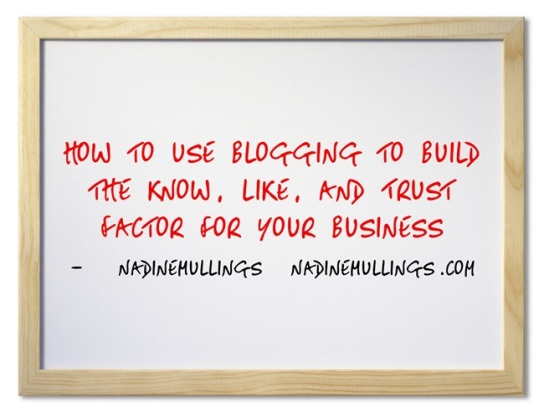 As an entrepreneur or small business owner, standing out from your competition is really important. Creating a unique statement that tells why you’re different is good, but as we know, people really like to buy from people they know, like, and trust, and a simple statement as to why you are good, may not be enough.
As an entrepreneur or small business owner, standing out from your competition is really important. Creating a unique statement that tells why you’re different is good, but as we know, people really like to buy from people they know, like, and trust, and a simple statement as to why you are good, may not be enough.
A great way to establish the know, like and trust factor is by blogging. Blogging is a great marketing strategy because if you consistently blog and promote your blog posts you will build an audience who will begin to know, like and trust you based on the content that you publish.
So let’s break down the way you can use a blog in order to establish the know, like, and trust factor and grow your business:
KNOW
Your blogging goal as an entrepreneur or small business owner is to become known as an expert in your field. People like to buy from people who are knowledgeable, helpful, and show that they care. Through your blog you can become known for providing valuable tips, tools, and techniques in your industry. If you consistently put out good content on your blog and that content is shared, this will help you to grow your “Know” factor.
LIKE
Another blogging goal is for people to get to like you. Your tone, writing style, and the content you provide on your blog should help with the like factor. Keep in mind your goal is not to be liked by everyone, but to be liked by your ideal target audience. When you know who you are talking to, and what their needs are, then you will be better able to create content that resonate with your target audience. Therefore, they will end up liking your content, and therefore, liking you.
TRUST
And lastly, your blogging goal is to build trust with your audience. This is a big one because people may buy from people that they don’t know that well, and may even buy from people they don’t always like, but they have to have a level of trust in you, your company, or your service in order to buy from you, so building the trust factor is really important. You can build trust with your audience by practicing what you preach, by doing what you say you are going to do, by being professional, by being reliable and consistent. When you show up on your blog consistently and provide good information, you are helping to build the “Trust” factor with your audience.
There are many factors why you should consider blogging in your marketing strategy and growing the know, like, and trust factor is just one reason why entrepreneurs and small business owners should be considering blogging. Are you currently blogging for your business? If so, do you feel blogging helps to build the know, like, and trust factor for your business? Share your opinion in the comments below.
Read Full Post |
Make a Comment ( None so far )
Posted on November 28, 2014. Filed under: Business, Business Development, Business Planning, Marketing, Marketing Plan, Small Business | Tags: differentiate, headlines, marketing calendar, Marketing Plan, referral partners, Target Market |
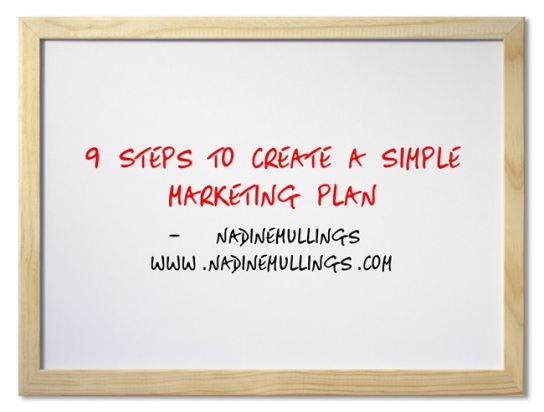
Having a Marketing Plan to grow your business is important, but sometimes creating the plan can feel overwhelming. This Blog Post simplifies the creation of your Marketing Plan, by breaking it down into 9 questions. When you answer these questions, you will create a simple marketing plan for your business:
- WHO is your target market?
You have to clearly define who you are trying to reach with your products and/or services. When you understand who your audience is, you are better able to market and promote to that target audience, so clearly define you target market including the demographics (age, gender, income, etc.) and pyschographics (beliefs, personality, hobbies, etc.) and this will help you to effectively market and promote your product or service to your target audience.
- WHAT is the problem that your target market has?
You have to clearly identify what problem or issue your target market may have. Most, if not all, products or services offer a solution to some type of problem. It may be a direct problem or an indirect problem, but your target market should have some type of problem that your product or service will help to alleviate.
- HOW does your product or service solve these problems?
After identifying the problem your target market has, now you have to show how your product or service solves that problem. It is important to not only identify the features of your product or service, but more importantly to identify the benefits of your product or service. People identify better with benefits rather than features. Saying your product is “light weight” is a feature, mentioning that your product is “easy and convenient to carry with you because it is light weight” is showing how that feature is a benefit. Taking the time to identify how you solve the problem and clearly articulating that in your marketing material will work to your advantage.
- WHERE is your Target Market?
The next step in your Marketing Plan is locating the target market that you have identified. The key is to find the places that your target market exists in large quantities. This is where you are going to get the most bang for your buck when it comes to your marketing activity. The more people you can reach who are in your target market and are located in one place (an event, conference, workshop, etc.) the better results you will be able to get from your marketing activity. You can find your target market in various places both online and offlline.
- HOW Do You Reach your Target Market?
Once you have located your target market, then you need to plan how you would like to reach them. What activities will you do to reach your target market. There are over 1,000 ways to reach your target audience (networking, advertising, email, video, speaking engagements, books, etc.) so you have to decide what method works best for your industry, your company, and your audience.
- WHO are your ideal referral partners?
Referrals can be one of the best ways to grow your business, so including in your marketing plan who your ideal referral partners are and working to build relationships with your ideal referral partners can really help you to grow your business. If you are able, including some type of incentive for referrals works really well.
- WHAT differentiates your company from all the other companies in the marketplace?
It is important to not only identify who your competitors are, but to identify how your company is different from the others in the marketplace. Once you clearly identify what makes you different than your competitors, then you are better able to articulate that in your marketing material to your clients and prospects.
- WHEN do you reach out to your target market and how much do you spend?
Planning your activity is a very important step that many small business owners and entrepreneurs neglect to do. The key to planning when you are going to reach out to your target audience and how much you are going to spend is to create a marketing calendar. This calendar will allow you to plan out when you will be doing certain marketing activities, what that marketing activity will be, and how much you plan to spend on a weekly, monthly, or yearly basis. Taking the time to do this activity can make a huge difference in the growth of your business.
- WHAT headlines will you use to catch the attention of your target audience
Thinking about the words that you are going to use to catch the attention of your target audience is very important, so taking the time to think about relevant keywords for your audience and your company will help you to craft the appropriate headlines for your marketing material.
Have you created a Marketing Plan for your business? If so, are there other aspects of your Marketing Plan that you include?
If you need assistance with creating a Marketing Plan for your business, we offer Marketing Plan Coaching for entrepreneurs and small business owners contact us to learn more.
Read Full Post |
Make a Comment ( None so far )
Posted on November 11, 2014. Filed under: Business, Business Planning, Email Results, Marketing, Marketing Plan, Small Business | Tags: conversion rate, GPS, Leads, MAP, Marketing Action Plan, Referrals, sales, sales conversations |
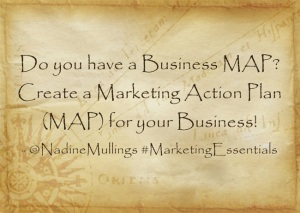 Do you have a business M.A.P.? Wondering what a business M.A.P. is, and why you would need one? It’s a Marketing Action Plan (M.A.P.), and you need one in order to take your business from one place to the next.
Do you have a business M.A.P.? Wondering what a business M.A.P. is, and why you would need one? It’s a Marketing Action Plan (M.A.P.), and you need one in order to take your business from one place to the next.
When you need to go somewhere, and you are not sure how to get there, you need directions. You can use a map to get the directions, now a days that map is within your GPS either in your smartphone or in your car. Well just like the map in your GPS, you need a M.A.P. for your business that is designed to take your business from point A to point B. The destination may be different for each business, but the need to have a plan and take action is always necessary to get your business from point A to point B.
Similar to when you are following the directions in your GPS, you may at times need to make a u-turn or change routes, but the overall map in the GPS is there to guide you and get you to your final destination. In fact, after we have made several miss steps or u-turns we love when we hear the words, “you have reached your destination“. With a business MAP, you may not hear a GPS system say, “you have reached your destination”, but you know you have reached your destination when you achieve the business goal that you set out to achieve.
For example, if your business goal is to increase your sales by 20%, you need to create a M.A.P. on how to get there. Instead of turns on highways and streets, the M.A.P. includes turns you can make in your marketing activity that can help you to reach your destination, so in the case of increasing sales, a M.A.P. could look something like this:
Point A- Sales are 50 units a month
Step 1- Increase leads by doing the following actions:
a. Attending more networking events
b. Placing ads on Social Media
c. Creating an email campaign
d. Creating an AdWord campaign
Step 2- Increase referrals by doing the following actions:
a. Joining a referral networking group
b. Looking for referral partners
c. Creating a referral partner program
d. Having a referral incentive
Step 3- Increase sales conversations by doing the following actions:
a. Having monthly webinars
b. Having monthly teleseminars
c. Having monthly in-person events
d. Having more one-on-one meetings with prospects
Step 4- Increase your conversion rate by doing the following actions:
a. Creating sales pages with good content and strong calls to actions
b. Creating emails with good content and strong call to actions
c. Creating videos with good content and strong call to actions
d. Adding testimonials to your website and sales pages
Point B- Measure the increase in sales
So as you can see the action that you take in your marketing action plan will determine the outcome of the destination of your business. You can create a plan for each business goal that you have and make adjustments to the actions when necessary.
Have you created your business M.A.P.? If so, what marketing activities do you include in order to reach your goals?
Read Full Post |
Make a Comment ( None so far )
Posted on October 27, 2014. Filed under: Business, Business Development, Business Events, Event Marketing, Marketing, Small Business | Tags: Livecast, Livestreams, Teleseminar, Videos, Virtual Events, Webinar |
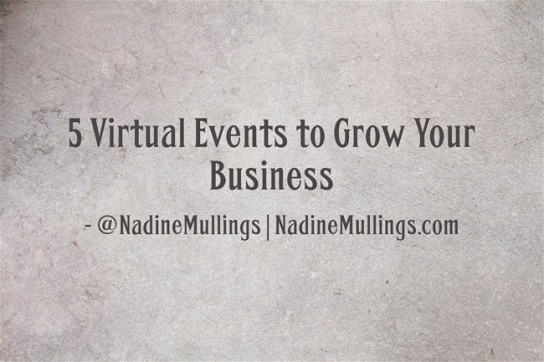
I’ve mentioned in several of my blog posts that having consistent events for your business is a great marketing strategy. Events give people an opportunity to learn more about you, more about the business, and more about your product or service. Over the last decade or so, Virtual Events have become very popular. I define virtual events as any type of event that does not take place in person.
Here are some examples of types of virtual events you can have to market your business:
- Tele-Seminars– Tele-Seminars have become very popular because they are easy to execute. All you need is a telephone and a conference line, and you will be able to conduct an event over the phone. Many companies are using this strategy to introduce prospects to their business, product, service, program, etc. Although teleseminars are a great strategy, the down side is the lack of visuals. A company has to rely solely on audio and many people need to see visuals. That is why most tele-seminars encourage listeners to go to a website to get more information and to sign-up.
- Webinars- Similar to tele-seminars, webinars have become super popular with the increased popularity of the use of the Internet. Webinars are seminars conducted via the web and participants are able to both hear the speakers and see the visuals. Webinars are also very easy to put together, all you need to do is use a webinar software that either has VOIP (Voice over Internet Protocol) or you can also use a conference line for people to be able to hear the webinar. Including a consistent webinar in your marketing strategy can be helpful to growing your business.
- Videos– Videos are a great way to conduct virtual events. Whether it’s a demo video, interview video, etc. videos allow you to create events and post them online to create a virtual event. You can pre-record the video or stream it live.
- Livecasts– Livecasts have also become popular because you are able to actually conduct a live training or seminar which includes a live audience and then stream it over the Internet so that it can be viewed by others online. This strategy is not totally virtual seeing that you may or may not have a live audience when taping the livecast.
- Livestreams– Similar to Livecasts, Livestreams are not totally virtual because a live stream usually occurs during an actual in-person event like a conference or seminar. The added ability to record it live and have people view the event via the Internet makes the Livestream a virtual event.
Are you including events in your marketing strategy? If so, are you also using Virtual Events to grow your business?
Read Full Post |
Make a Comment ( None so far )
Posted on October 14, 2014. Filed under: Business, Business Events, Event Marketing, Marketing, Small Business | Tags: Appreciation, Event Budget, Event Marketing, Event Promotion, Livestream, social media, Survey, target audience |
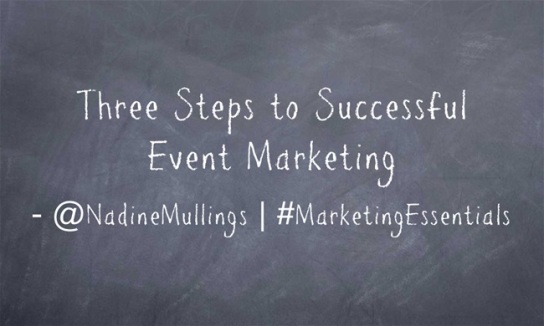
Having consistent events for your business is a great marketing strategy. Events are a great way for people to get to know you, like you, and trust you, which we all know is the key to getting more business. However, putting on events is not always an easy task. The hardest thing about events is getting people to attend, so this article goes through the 3 steps to successfully market your next event.
Step 1- Pre-Event
Pre-event is the planning phase which involves all the activities that go into planning an event up until the day that the event occurs. The planning phase should include the following key elements:
- Audience– who is the event intended for? Just like all marketing strategies, the first step is to understand who you are trying to reach which includes the usual demographics and the even more important psychographics of your audience. The demographics covers the age, gender, income level, etc. while the psychographics is going to cover lifestyle, beliefs, attitudes, etc.
- Purpose– What is the goal of the event? Is the event mainly to get your name and brand out there so you can create brand awareness, is it to get sales, is it to grow your prospect list, is it to show appreciate to your customers, is it to educate the market on your industry, etc. There are so many reasons to have an event, and it is important that you are clear on the specific reason you are having the event.
- Promotion– How are you going to get the word out about your event? Are you going to use traditional advertising channels like radio, TV, newspaper, etc., or are you going to use new media like social media, blogs, email, etc., or a combination of both forms of media? List all the ways you are going to promote the event and how often you are going promote it up until the day of the event.
- Budget– It is important to establish a budget for the event. How much are you willing to spend on the promotion of the event and the actual event itself? No matter how big or small of an event you are planning, it is important for you to set an overall budget for the event.
Step 2- During the Event
The marketing of the event does not end while the event is taking place, in fact, some of the best promotion can be done at the event. Some ways that you can promote during the event include:
- Live Stream– This has become popular for larger events. With the technology available to be able to broadcast the event around the world, many people are offering free or paid livestreams for people to be able to have access to the event virtually. This helps to amplify your event goal, because not only will you be reaching the people who attend your event in person, but you can also reach people anywhere in the world. It goes back to the purpose of your event. If a livestream will help you reach your overall goal and it is in your event budget, then it may be something to consider.
- Social Media– Social Media and Social Networks like Twitter and Instagram are great to promote not only before the event, but also during the event because it is a way for people who are at the event to connect, and also people who are not at the event to get some of the information presented, and to see some of the activity. The best way to be effective on social networks is to create a specific hashtag (#) that can be used throughout the event. This allows for easy grouping and visibility on the network when it comes to conversations and pictures about the event. Again it is another way to amplify the event to other people who may not be in attendance.
Step 3- Post-Event
The marketing of the event does not end after the event. Depending on how often you will be having the event or having other events for your business, the end of the event is a great way to market the next event.
- Sign-ups– Be sure to promote the next event, and whenever possible even encourage individuals to sign-up for the next event on the spot. That helps you to secure your audience for your next event.
- Feedback– Getting feedback after an event is not only great research on how you can improve your next event, but it also shows your attendees that you care about the events and their feedback is valuable. Event surveys are a great way to get this type of feedback and the information that you receive from the attendees can help you with the creation and promotion of the next event
- Appreciation– Showing your attendees that you appreciated their attendance is also a great post-event activity. This could be in the form of an email or a thank you card. Depending on the size and scope of your event, you would need to decide what is the most appropriate way for you to show your attendees appreciation.
Do you have consistent events to promote your business? If so, what do you include in your pre-event, during event, and post event planning?
Read Full Post |
Make a Comment ( None so far )
Posted on September 23, 2014. Filed under: Business, Business Development, Marketing, Small Business | Tags: Blogging, Customer Cards, Email, Referral Business, Relationship Marketing, repeat business, Retain Business, social media |
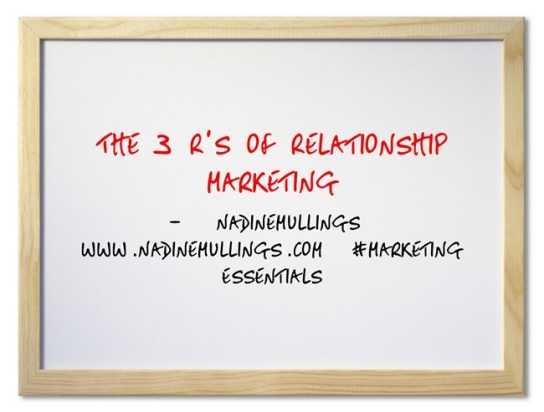 In my previous post, How to Grow Your Business with Relationship Marketing, I defined Relationship Marketing as the activities involved in building a greater connection with your clients, prospects and partners. This strong connection often leads to the sale of products or services, and also increases loyalty to your brand or company.
In my previous post, How to Grow Your Business with Relationship Marketing, I defined Relationship Marketing as the activities involved in building a greater connection with your clients, prospects and partners. This strong connection often leads to the sale of products or services, and also increases loyalty to your brand or company.
The benefits of using Relationship Marketing strategies in your business include the following 3 R’s:
- Referral Business- Referral business can be one of the best ways to get business, because a referral basically comes with an endorsement from the person who is doing the referring. A great source of referrals comes from current clients, partners, and even your prospects, so building a strong relationship with your clients, prospects, and partners becomes vital for your business. In order for someone to feel comfortable referring you, they must know, like and trust you. When you use online relationship marketing strategies including, email, blogging, social media, etc., these activities help people to get to know you, like you and trust you, which in turn gives them confidence in referring your products or services to others. Referrals can be a great source of new business and can be a large percentage of where you get your business from, so nurturing your relationships with relationship marketing is a great way to grow your business through referrals.
- Repeat Business– Once a person becomes your customer by purchasing a product or a service, your next goal should be to stay top of mind so that they will purchase that product or service again if they need it, or they will consider your company for other products or services that they may need. That’s why conducting relationship marketing with your current customers by practicing activities to nurture the relationship and stay top of mind will help with getting repeat business from your current customers. Some relationship marketing strategies you can use for current customers include; Customer Appreciation Events, Sending Cards on special occassions including: Birthdays, Holidays, Anniversaries, Offering VIP discounts for current customers, etc.
- Retain Business– It tends to be more expensive to get a new customer than it is to retain the customers that you have, so it is important to nurture the relationships that you have with your current customers to make sure that you keep their business. Some relationship marketing strategies to retain business include, showing appreciation for their business by sending “Thank You” cards, making follow-up calls to make sure they are satisfied with the service they have received or are receiving from your company, providing an excellent customer experience. The customer experience includes pre-purchase, during purchasing, and post purchase. How are you making sure that each step is a good encounter for your customer?
Are you using Relationship Marketing strategies to retain business and get repeat and referral business? What are some other relationship marketing strategies you can use to grow your business?
Read Full Post |
Make a Comment ( None so far )
Posted on August 25, 2014. Filed under: Business, Marketing, Small Business, Social Media | Tags: HootSuite, Social Business, Social Collaboration, Social ROI |
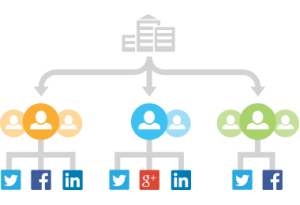
Image Source: copyright Hootsuite
As mentioned in 8 Tips for Creating a “Social Business” (Part 1), having a “Social Business” is different than just being on a “Social Network”. In order to be “social” on a social network, you must have a “social business”.
In this blog post, I will share tips 5-8 for creating a social business. The inspiration and original content for this post is provided by Evan LePage. Originally posted on HootSource.
Tip 5- Collaborate
Be sure to encourage your team members to distribute new learning both within the team and your organization as a whole. Keep an ongoing loop of discovery and dissemination where best practices, positive messaging or common questions are put forward for comment or collaboration. Social platforms like Yammer and Hootsuite Conversations are exceptional tools for supporting secure internal conversation and exchange of ideas.
Ultimately better internal collaboration supports improved external engagement, keeping messaging consistent, intelligent and brand-appropriate.
Tip 6- Secure
Fear over losing control is an understandable barrier to implementing social media across an organization. It is important to note that mistakes are preventable. In many popular cases the missteps were handled well and the damage to each organization was more along the lines of temporary embarrassment than anything permanent, but why not stop them before they occur?
Hootsuite developed Secure Profiles specifically in response to instances like these to put a solid measure of prevention in place. This provides an extra prompt when publishing to important branded accounts, preventing errant posts intended for personal accounts.
Limited Permissions is another unique security feature. Hootsuite offers multiple levels of account access and places limits on which team members can participate in outbound social conversation directly. The Limited Permissions puts control over publishing firmly in the hands of those who are most trusted. Your social tools should too.
Tip 7- Measure ROI
Tie social to the big picture by linking it to organizational and departmental goals. Users can start with tracking the Like, @mention, Retweet or Follow, but tap in to the power to go much further and deeper. Build the capacity for measurement into every social action. Use URL shorteners, like Hootsuite’s ow.ly links, to track your click-throughs. Integrate Google Analytics and Facebook Insights to track on-site conversions or drill in to geographic disparities in data.
One of the more powerful, recent integrations at Hootsuite is the partnership with Adobe SiteCatalyst. For the first time ever, you’re able to track the path from social message to conversion and attach a dollar value to individual social messages against Key Performance Indicators. You’re able to see which social platform performs best against certain kinds of messaging, analyze which of your Social Advocates is driving more revenue per message and understand what times of day work best for which kinds of communication.
Reporting is important. With Hootsuite you can use data gained from Adobe SiteCatalyst, Webtrends, Facebook Insights, Google Analytics, Google+ Pages Analytics, Twitter Profile Stats, Hootsuite’s custom ow.ly Click Stats to generate easy, drag and drop social analytics reports shared easily by email. More importantly, you can analyze that data to optimize future programs and messaging.
Tip 8- Amplify
When you have a piece of content that is a “hit,” double down. One of the benefits of good measurement and understanding of your data is the ability to hone your messaging and understand what did and didn’t work from a content perspective. Organic social is testing your content for you. Paid social allows you to commit dollars with data-backed belief in your programs and messaging. Invest in promoted tweets, accounts or trends across social platforms or accounts that have already demonstrated the highest yield.
With paid social companies can drill down to microtarget users – either their own followers or people “like” their followers – based on literally hundreds of different interests, by country and city, gender and even device. Companies only pay when users “engage” with the Promoted Tweet in some way, i.e. by clicking on a link or retweeting it. Native ads are also very agile. Members of an organization can log in at any time, create a message and instantly push it to a global audience as a Promoted Tweet. An eBay-style bidding system means prime ad spots always go for the lowest price, minimizing ad spend. The time-consuming (not to mention pricey) requirements of traditional ad campaigns – design teams, creative agencies and media buyers – can’t make the same claim.
Summary:
Social is here to stay and to maintain a competitive advantage, businesses need to stay abreast of this ever-evolving space. Hootsuite Pro helps teams engage with audiences and analyze campaigns across multiple social networks like Twitter, Facebook and LinkedIn from one secure web-based dashboard.
Read Full Post |
Make a Comment ( None so far )
« Previous Entries
 There are many advantages to starting a business blog. In fact, I talked about one of the major benefits of a business blog in my blog post, How to Use Blogging to Build the Know, Like, and Trust Factor for Your Business, but what most people don’t necessarily talk about is the “truth” about blogging. So in this blog post I will uncover some of the truths about blogging for your business:
There are many advantages to starting a business blog. In fact, I talked about one of the major benefits of a business blog in my blog post, How to Use Blogging to Build the Know, Like, and Trust Factor for Your Business, but what most people don’t necessarily talk about is the “truth” about blogging. So in this blog post I will uncover some of the truths about blogging for your business:










